The Mastery: The Bronze David by Donatello
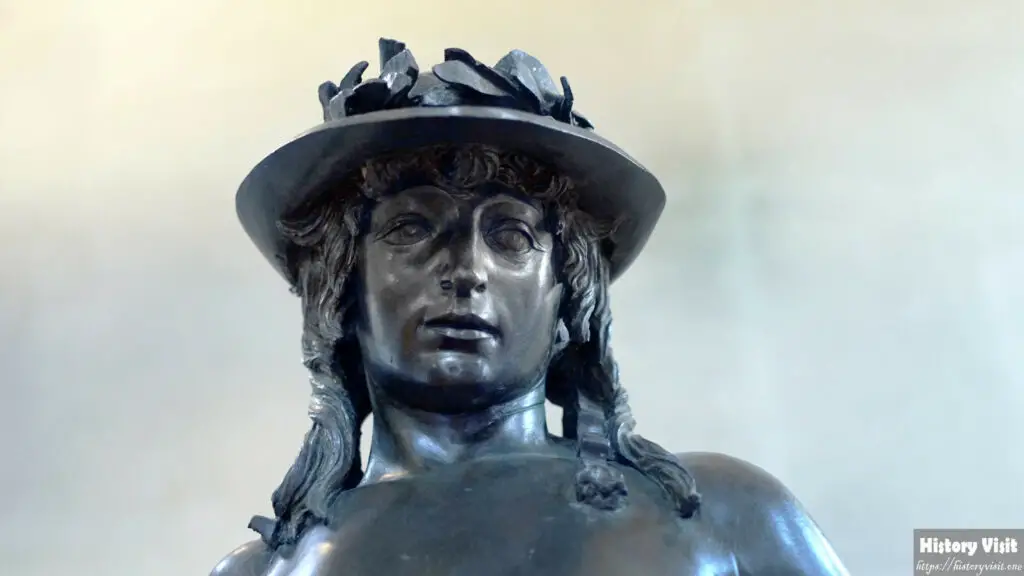
Introduction
In the annals of art history, few names resonate as profoundly as that of Donatello, the pioneering sculptor of the Italian Renaissance. Donatello’s contributions to the art world are legion, but perhaps none are as emblematic of his genius as “The Bronze David,” housed within the Museo Nazionale del Bargello in Florence, Italy. Crafted during the 1440s, this masterpiece stands as a testament to Donatello’s innovation, technical skill, and artistic vision, encapsulating the spirit of the Renaissance in its most exquisite form.
Donatello’s career unfolded against the backdrop of a burgeoning Renaissance movement, characterized by a fervent revival of classical ideals and a newfound appreciation for humanism. Born in Florence in the early 15th century, Donatello emerged as a trailblazer in the realm of sculpture, pushing the boundaries of form, technique, and expression. His works, including “The Bronze David,” epitomize the Renaissance ethos of rediscovery, renewal, and a relentless pursuit of beauty and truth.
Donatello’s Renaissance Innovation
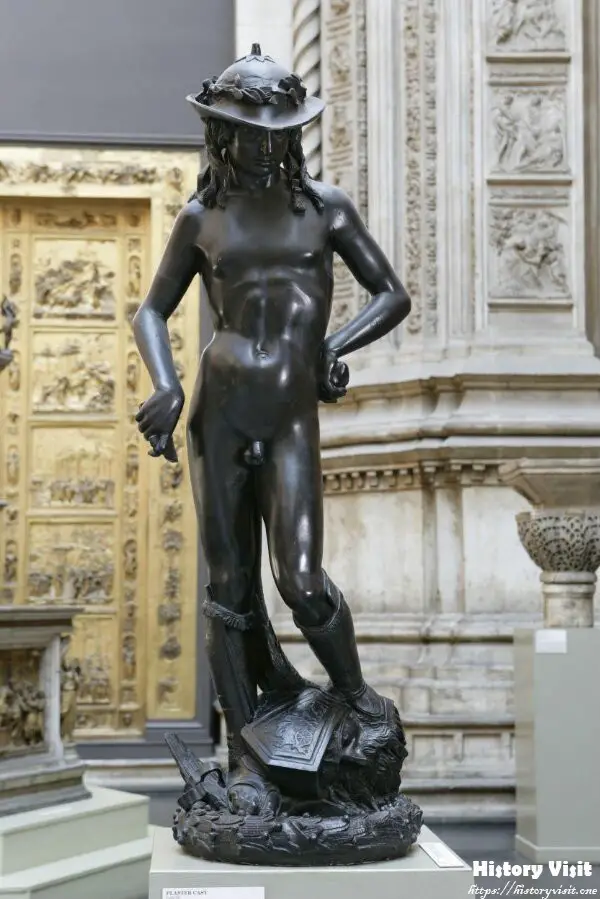
At the heart of Donatello’s artistic revolution lay his relentless experimentation with form, material, and technique. Unlike his predecessors, who predominantly worked in marble, Donatello was drawn to the lustrous allure of bronze, a medium that allowed for greater intricacy and dynamism in his sculptural compositions. “The Bronze David” stands as a testament to Donatello’s mastery of this medium, showcasing a level of detail and expressiveness that revolutionized Renaissance sculpture.
Beyond his material innovations, Donatello also distinguished himself through his keen understanding of human anatomy and emotion. In “The Bronze David,” he eschews the traditional portrayal of David as a triumphant warrior, opting instead for a more introspective and vulnerable interpretation. The statue captures David in a moment of contemplation, his slingshot casually slung over his shoulder as he gazes into the distance with a mixture of determination and trepidation. This departure from convention not only reflects Donatello’s artistic daring but also his commitment to imbuing his sculptures with psychological depth and nuance.
Donatello’s Renaissance innovation extended beyond the confines of the studio, permeating every aspect of his artistic practice. His willingness to challenge established norms and push the boundaries of his craft laid the groundwork for future generations of artists, leaving an indelible mark on the course of Western art history.
Contextualizing “The Bronze David”
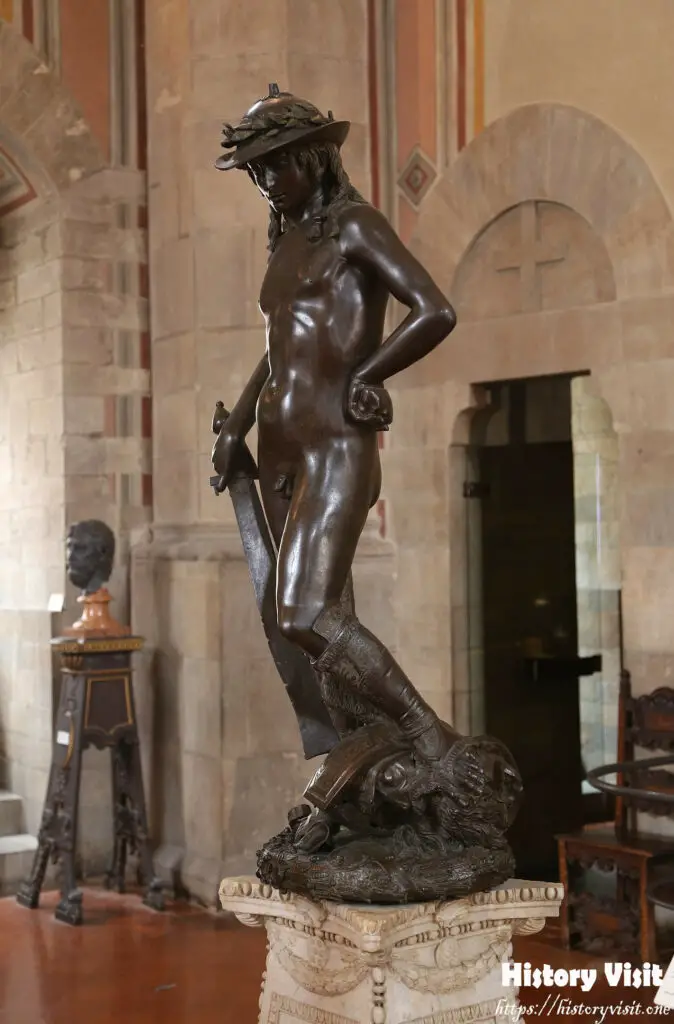
To fully appreciate the significance of “The Bronze David,” one must consider the historical and cultural context in which it was created. The biblical figure of David, renowned for his defeat of the giant Goliath, held particular resonance for the citizens of Florence during the Renaissance. As the symbol of the city-state’s triumph over tyranny and oppression, David became an emblem of Florentine identity and resilience.
Against this backdrop of political and cultural upheaval, Donatello received a commission to create a statue of David for the Medici family, the de facto rulers of Florence at the time. “The Bronze David” thus served a dual purpose: to celebrate the city’s storied past and to affirm the Medici’s authority and legitimacy in the eyes of its citizens. Donatello’s decision to depict David not as a triumphant hero but as a contemplative youth speaks to the complexities of Florentine politics and society, where power and vulnerability were inextricably intertwined.
The setting of “The Bronze David” within the Museo Nazionale del Bargello further enriches its historical significance. Originally housed in the courtyard of the Palazzo Medici, the statue was later moved to the Bargello, a former fortress turned museum that now serves as a testament to the rich artistic heritage of Florence. Here, amidst a treasure trove of Renaissance masterpieces, “The Bronze David” continues to captivate and inspire visitors from around the world, a timeless testament to Donatello’s enduring legacy.
Design and Composition
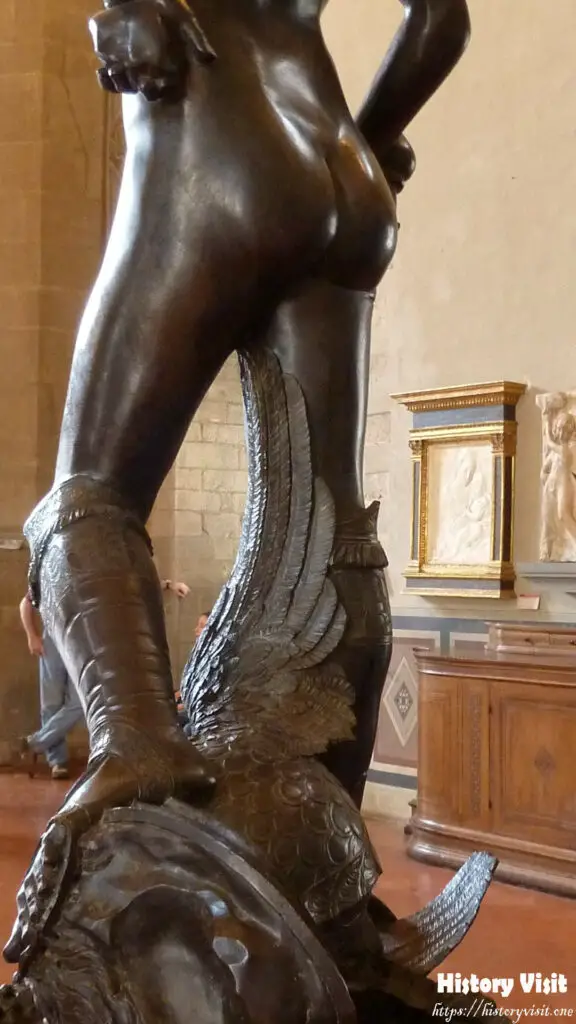
Donatello’s meticulous attention to detail and masterful composition are evident in every aspect of “The Bronze David.” Standing just over five feet tall, the statue exudes a sense of vitality and dynamism, its lifelike proportions and naturalistic pose capturing the essence of youth and vigor. David’s contrapposto stance, with his weight shifted onto one leg and his torso slightly twisted, imbues the figure with a sense of movement and grace, as if caught in a moment of spontaneous action.
The interplay of light and shadow further enhances the statue’s sculptural beauty, highlighting the intricate musculature of David’s body and the delicate folds of his drapery. Donatello’s skillful manipulation of bronze allows for a level of expressiveness and fluidity that was unprecedented in Renaissance sculpture, creating a sense of immediacy and intimacy that draws the viewer in.
Central to the composition of “The Bronze David” is the figure’s gaze, which serves as a focal point of both physical and emotional tension. David’s eyes, cast downward in a contemplative gaze, convey a sense of introspection and resolve, hinting at the inner turmoil and moral ambiguity of his biblical narrative. This juxtaposition of outward confidence and inner vulnerability speaks to Donatello’s ability to capture the complexities of the human experience with unparalleled sensitivity and insight.
Technical Mastery and Artistic Expression
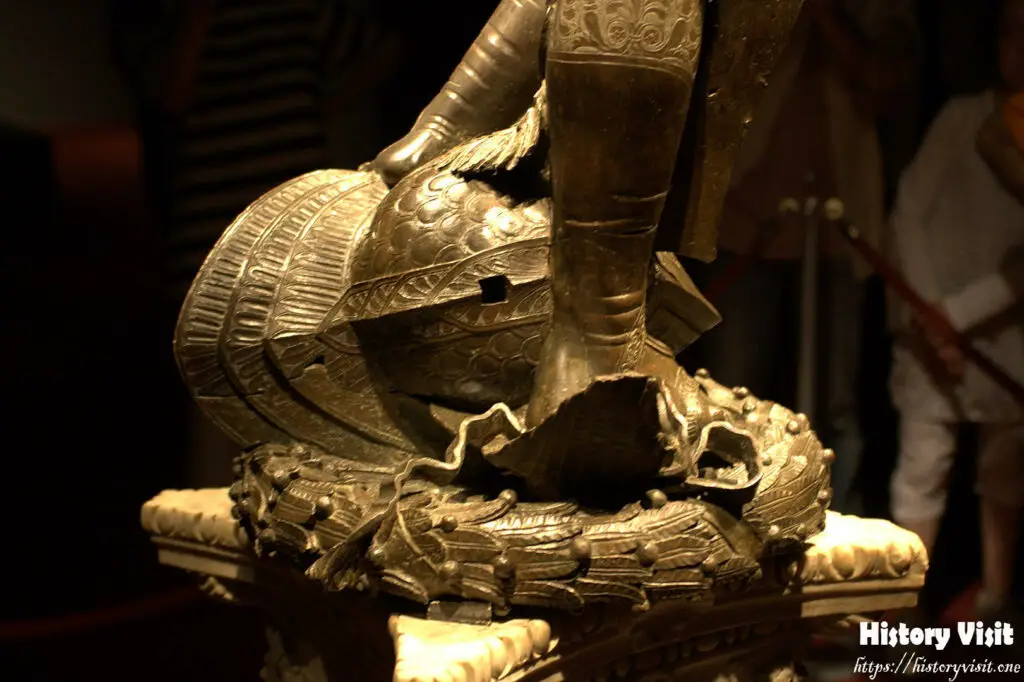
“The Bronze David” stands as a testament to Donatello’s unparalleled technical skill and artistic vision. From the delicate rendering of David’s features to the intricate detailing of his clothing and accessories, every aspect of the statue reflects a level of craftsmanship that borders on the miraculous. Donatello’s mastery of bronze casting allowed him to achieve a level of precision and realism that was previously unimaginable, elevating his sculptures to the realm of true works of art.
Central to Donatello’s artistic practice was his commitment to imbuing his sculptures with a sense of emotional depth and psychological complexity. In “The Bronze David,” this is evident in the subtle nuances of expression and posture that convey a rich inner life beneath the surface. David’s furrowed brow and clenched jaw suggest a sense of determination and resolve, tempered by a lingering sense of doubt and apprehension. It is this juxtaposition of strength and vulnerability that lends the statue its timeless resonance, inviting viewers to contemplate the universal themes of courage, adversity, and the human condition.
Beyond its technical brilliance and emotional resonance, “The Bronze David” also serves as a testament to Donatello’s enduring legacy as one of the greatest sculptors of the Renaissance. His innovative approach to form, material, and expression laid the groundwork for future generations of artists, shaping the course of Western art history for centuries to come. As a masterpiece of Renaissance sculpture, “The Bronze David” continues to captivate and inspire viewers with its timeless beauty and profound insight into the human soul.
Legacy and Influence
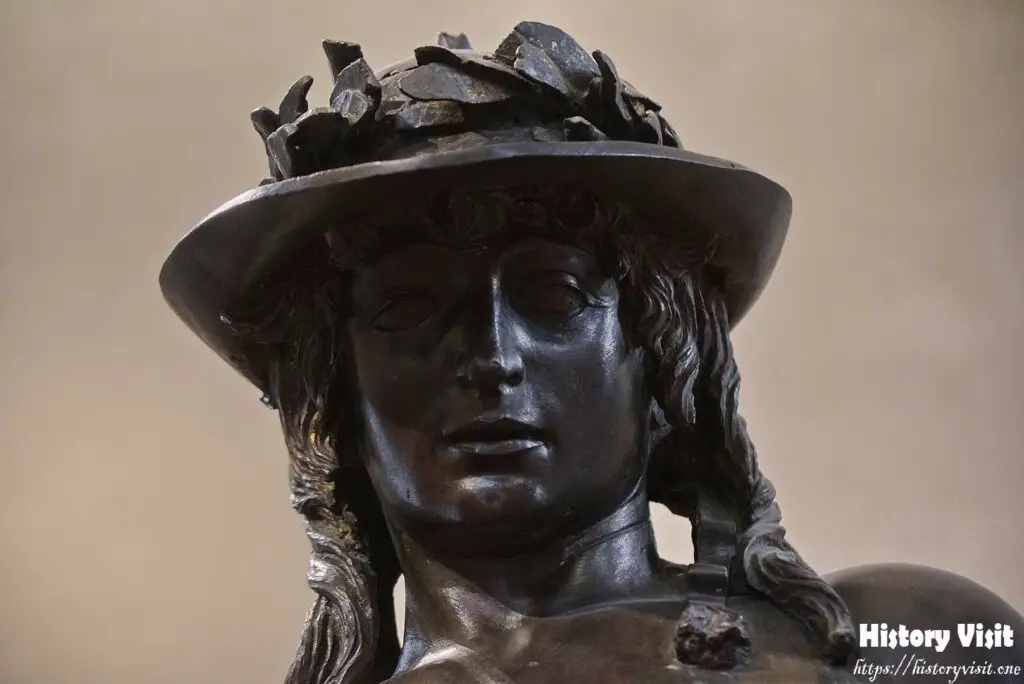
Donatello’s legacy reverberates throughout the corridors of art history, casting a long shadow over subsequent generations of sculptors and artists. His innovative approach to form, material, and technique not only revolutionized Renaissance sculpture but also laid the groundwork for the artistic movements that would follow in its wake. From the towering figures of the High Renaissance to the dynamic compositions of the Baroque period, Donatello’s influence can be felt in every corner of Western art.
One of the most significant aspects of Donatello’s legacy is his pioneering use of bronze as a sculptural medium. By harnessing the malleability and luster of this precious metal, Donatello was able to achieve levels of detail and expressiveness that were previously unimaginable in sculpture. His mastery of bronze casting techniques set a new standard for excellence in Renaissance art, inspiring future generations of sculptors to push the boundaries of their craft.
Beyond his technical innovations, Donatello’s artistic vision continues to resonate with contemporary audiences, offering timeless insights into the human condition. “The Bronze David,” with its portrayal of a vulnerable yet resolute hero, speaks to the universal themes of courage, adversity, and the triumph of the human spirit. In an age marked by political turmoil and social upheaval, Donatello’s depiction of David as a symbol of resilience and determination remains as relevant and poignant as ever.
Moreover, Donatello’s legacy extends beyond the realm of sculpture to encompass a broader cultural and intellectual milieu. As a leading figure of the Renaissance, he played a pivotal role in the rediscovery of classical ideals and the promotion of humanist values. His commitment to portraying the human form with dignity and reverence helped to usher in a new era of artistic enlightenment, paving the way for the cultural flourishing that would define the Italian Renaissance.
In the centuries since Donatello’s passing, his legacy has continued to evolve and adapt to the changing currents of artistic expression. From the neoclassical revival of the 18th century to the avant-garde experimentation of the modern era, artists have looked to Donatello as a guiding light, drawing inspiration from his innovative spirit and unwavering commitment to artistic excellence. As we continue to navigate the complexities of the contemporary world, Donatello’s legacy serves as a beacon of hope and inspiration, reminding us of the transformative power of art to transcend the boundaries of time and space.
Conclusion
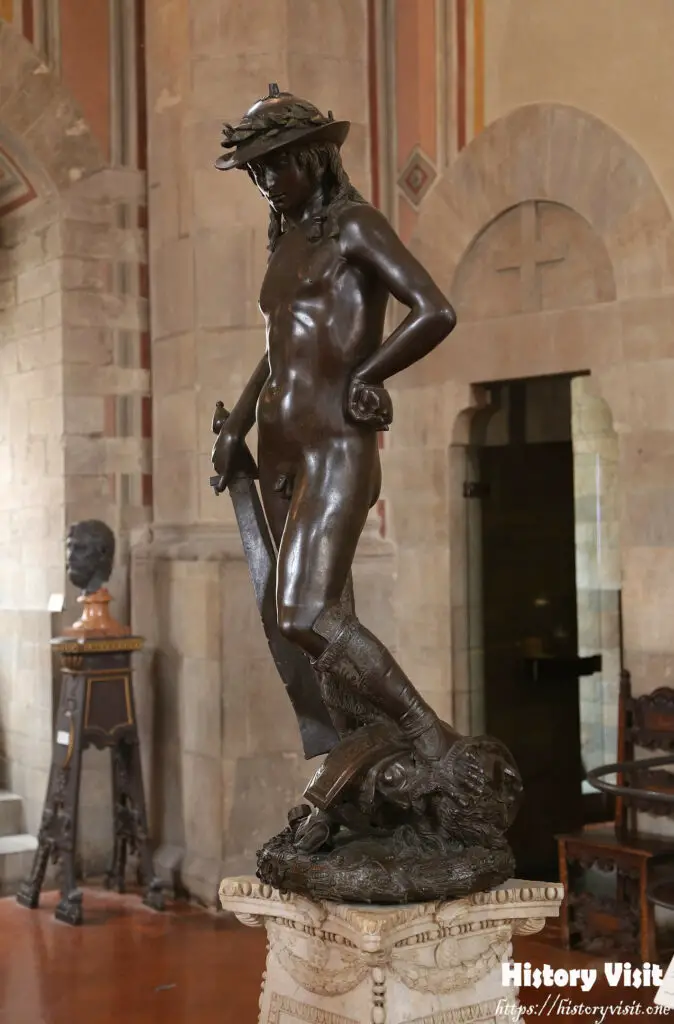
In conclusion, “The Bronze David” by Donatello stands as a crowning achievement in the pantheon of Renaissance art, a masterpiece that continues to captivate and inspire audiences centuries after its creation. Through his innovative use of bronze, his mastery of form and technique, and his profound insight into the human condition, Donatello transformed the landscape of sculpture and left an indelible mark on the course of Western art history.
From its humble origins in the workshops of Florence to its current residence in the Museo Nazionale del Bargello, “The Bronze David” has endured as a symbol of artistic excellence and creative vision. Donatello’s portrayal of David as a contemplative youth, poised on the brink of greatness, speaks to the timeless themes of courage, resilience, and the triumph of the human spirit. In a world beset by uncertainty and upheaval, the statue serves as a reminder of the enduring power of art to uplift, inspire, and unite.
As we reflect on Donatello’s legacy, we are reminded of the transformative potential of artistic expression to transcend the boundaries of time and space, and to speak to the universal truths that bind us all together. “The Bronze David” stands as a testament to the enduring legacy of one of history’s greatest sculptors, a beacon of hope and inspiration for generations to come. In the words of the poet John Keats, “A thing of beauty is a joy forever,” and indeed, “The Bronze David” remains a source of joy, wonder, and awe for all who encounter it.


